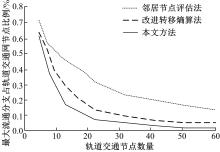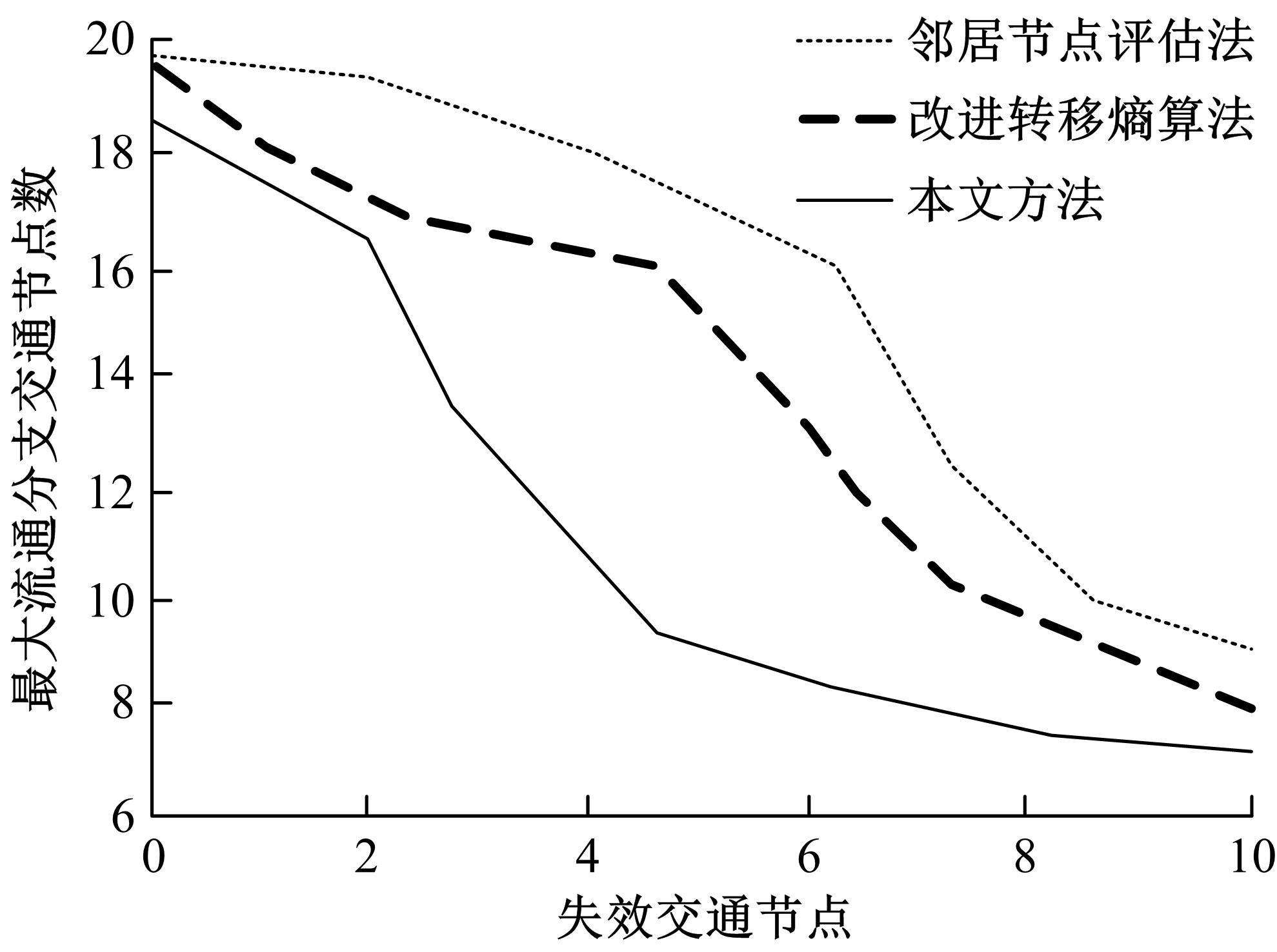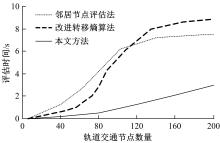吉林大学学报(工学版) ›› 2022, Vol. 52 ›› Issue (12): 2845-2851.doi: 10.13229/j.cnki.jdxbgxb20211297
基于粗糙集理论的轨道交通节点重要度评估算法
- 重庆交通大学 信息科学与工程学院,重庆 400074
Evaluation algorithm of rail transit node importance based on rough set theory
- School of Information Science & Engineering,Chongqing Jiaotong University,Chognqing 400074,China
摘要:
为了更好地保护交通重要节点,提出了基于粗糙集理论的轨道交通节点重要度评估算法。针对轨道交通各节点中具有不确定性的客流因素,利用边界域概念对模糊数据进行清晰描述;对整理出的概念集合及元素进行知识约简,加入决策规则完成信息量求解;判断节点客流量大小,凭借知识熵确定节点权重,从节点度中心性、节点接近中心性以及节点阶数中心性3个维度评估节点重要度。实验证明,本文算法评估时间在3 s内,评估时间较短,且评估结果准确。
中图分类号:
- U491.13
| 1 | 张喜平, 李永树, 刘刚, 等. 节点重要度贡献的复杂网络节点重要度评估方法[J]. 复杂系统与复杂性科学, 2014, 11(3): 26-32, 49. |
| Zhang Xi-ping, Li Yong-shu, Liu Gang, et al. Evaluation method of importance for nodes in complex networks based on importance contribution[J]. Complex Systems and Complexity Science, 2014,11(3): 26-32, 49. | |
| 2 | 张才斌, 游昊, 李本瑜, 等. 计及拓扑结构和运行状态的支路重要度评估方法[J]. 电力系统自动化, 2017, 41(7): 15-20. |
| Zhang Cai-bin, You Hao, Li Ben-yu, et al. Assessment method of branch importance considering topological structure and operation state[J]. Power System Automation, 2017,41(7): 15-20. | |
| 3 | 李军, 王秋莉. KPCA-KELM在短期交通流量预测中的应用[J]. 江苏大学学报:自然科学版, 2018, 39(5): 570-575. |
| Li Jun, Wang Qiu-li. Application of KPCA-KELM in short-term traffic flow prediction[J]. Journal of Jiangsu University(Natural Science Edition), 2018, 39(5): 570-575. | |
| 4 | 董哲伟, 徐永能. 轨道交通十字换乘车站缓冲区域的优化设计[J]. 江苏大学学报:自然科学版, 2019, 40(1): 8-15, 21. |
| Dong Zhe-wei, Xu Yong-neng. Optimization design of passenger flow buff area for crossover interchange urban rail station[J]. Journal of Jiangsu University(Natural Science Edition), 2019, 40(1): 8-15, 21. | |
| 5 | 黎枫,刘欣然. 粗糙集理论在旅游突发事件应急响应中的应用[J]. 技术经济, 2019, 38(3): 78-87. |
| Li Feng, Liu Xin-ran. Application of rough set theory in tourism emergency response[J]. Technical Economy, 2019, 38(3): 78-87. | |
| 6 | 林琳, 陈志英. 基于粗糙集神经网络和振动信号的高压断路器机械故障诊断[J].电工技术学报,2020, 35(): 277-283. |
| Lin Lin, Chen Zhi-ying. Mechanical fault diagnosis of high voltage circuit breakers based on rough set neural networks and vibration signals[J]. Journal of Electrotechnics, 2020, 35(Sup.1): 277-283. | |
| 7 | 米据生, 陈锦坤. 基于图的粗糙集属性约简方法[J]. 西北大学学报:自然科学版, 2019, 49(4): 508-516. |
| Mi Ju-sheng, Chen Jin-kun. Graph-based approaches for attribute reduction in rough sets[J]. Journal of Northwest University (Natural Science Edition), 2019, 49(4): 508-516. | |
| 8 | 邵为爽, 李晓红, 张天抒,等. 基于粗糙集理论的数据挖掘技术及应用[J]. 煤炭技术, 2019, 38(6): 152-154. |
| Shao Wei-shuang, Li Xiao-hong, Zhang Tian-shu, et al. Datamining technology and its application based on rough set theory[J]. Coal Technology, 2019, 38(6): 152-154. | |
| 9 | 刘富春, 赵毅澎, 赵锐. 基于粗糙集理论的离散事件系统不透明性的验证算法[J]. 控制理论与应用,2019,36(8):1259-1264. |
| Liu Fu-chun, Zhao Yi-peng, Zhao Rui. Verification algorithm for opacity of discrete-event systems with rough set theory[J]. Control Theory and Application, 2019, 36(8): 1259-1264. | |
| 10 | 薛锋, 何传磊, 黄倩. 成都地铁网络的关键节点识别方法及性能分析[J]. 中国安全科学学报, 2019, 29(1): 93-99. |
| Xue Feng, He Chuan-lei, Huang Qian. Identification of key nodes in chengdu metro network and analysis of network performance[J]. Chinese Journal of Safety Science, 2019, 29(1): 93-99. | |
| 11 | 王安,顾益军. 基于社区划分的节点重要性评估方法[J]. 计算机工程与应用, 2020, 56(8): 42-48. |
| Wang An, Gu Yi-jun. Nodes importance ranking method based on community detection[J]. Computer Engineering and Application, 2020,56(8): 42-48. | |
| 12 | 程子轩,乔木. 物联网入侵的最优通信节点选取算法[J]. 吉林大学学报:理学版, 2019, 57(4): 903-909. |
| Cheng Zi-xuan, Qiao Mu. Optimal communication node selection algorithm for intrusion of internet of things[J]. Journal of Jilin University (Science Edition), 2019, 57(4): 903-909. | |
| 13 | 张强, 曹军海, 宋太亮,等. 基于合度的装备保障网络节点重要性评估[J]. 系统仿真学报, 2019, 31(12): 2657-2663. |
| Zhang Qiang, Cao Jun-hai, Song Tai-liang, et al. Evaluation method of node importance in equipment support network based on polymeric degree[J]. Journal of System Simulation, 2019, 31(12): 2657-2663. | |
| 14 | 谭阳红, 张婧, 李肖. 基于复杂网络理论的电网节点重要度评估[J]. 计算机工程, 2019, 45(11): 281-286, 297. |
| Tan Yang-hong, Zhang Jing, Li Xiao. Importance evaluation of power grid nodes based on complex network theory[J]. Computer Engineering, 2019,45(11): 281-286, 297. | |
| 15 | 琚倩茜, 姜红丙. 城市轨道交通工程关键接口识别方法研究[J]. 铁道科学与工程学报, 2020, 17(10): 2672-2679. |
| Ju Qian-qian, Jiang Hong-bing. Research on key interface points identification for metro projects[J]. Journal of Railway Science and Engineering, 2020,17(10): 2672-2679. | |
| 16 | 梁青槐, 柴树山, 钟思敏, 等. 城市轨道交通站点网络结构综合重要度识别[J]. 铁道工程学报, 2019, 36(9): 66-71. |
| Liang Qing-huai, Chai Shu-shan, Zhong Si-min, et al. Identification of comprehensive importance of urban rail transit stations in network structure[J]. Journal of Railway Engineering, 2019, 36(9): 66-71. | |
| 17 | 李国栋, 王鹏. 基于作战环的作战体系节点重要性评价方法[J]. 火力与指挥控制, 2019, 44(8): 7-11. |
| Li Guo-dong, Wang Peng. Node importance evaluation for operation system of systems based on operation loop[J]. Firepower and Command and Control, 2019, 44(8): 7-11. | |
| 18 | 王迎, 郭宇婷, 田宗忠. 基于TOPSIS模型的城市群公路枢纽节点重要度评价[J]. 公路, 2019, 64(8): 141-145. |
| Wang Ying, Guo Yu-ting, Tian Zong-zhong. Importance evaluation of highway hub nodes in urban agglomeration based on TOPSIS model[J]. Highway, 2019, 64(8): 141-145. | |
| 19 | 李炅菊, 黄宏光, 舒勤. 相依网络理论下电力通信网节点重要度评价[J]. 电力系统保护与控制, 2019, 47(11): 143-150. |
| Li Ji-ju, Huang Hong-guang, Shu Qin. Evaluation method for node importance in power telecommunication network based on interdependent network theory[J]. Power System Protection and Control, 2019, 47(11): 143-150. | |
| 20 | 吕彪, 高自强, 刘一骝. 道路交通系统韧性及路段重要度评估[J].交通运输系统工程与信息,2020, 20(2): 114-121. |
| Lv Biao, Gao Zi-qiang, Liu Yi-liu. Evaluation of road transportation system resilience and link importance[J]. Transportation System Engineering and Information, 2020, 20(2): 114-121. | |
| 21 | 国强, 崔玉强, 王勇. 无线传感器网络中基于动态簇的节点调度算法[J].吉林大学学报:工学版, 2022,52(6):1466-1476. |
| Guo Qiang, Cui Yu-qiang, Wang Yong. Nodes scheduling algorithm based on dynamic cluster in wireless sensor network[J]. Journal of Jilin University(Engineering and Technology Edition), 2022, 52(6): 1466-1476. | |
| 22 | 张昕, 王慧慧, 严沛, 等.一种面向多维复杂网络的节点传播重要性算法[J]. 计算机科学, 2019, 46(): 348-353. |
| Zhang Xin, Wang Hui-hui, Yan Pei, et al. Node propagation importance algorithm for multi-dimensional complex networks[J]. Computer Science, 2019,46(Sup.2): 348-353. |
| [1] | 王菁,万峰,董春娇,邵春福. 城市轨道交通站点吸引范围及强度建模[J]. 吉林大学学报(工学版), 2023, 53(2): 439-447. |
| [2] | 张惠臻,高正凯,李建强,王晨曦,潘玉彪,王成,王靖. 基于循环神经网络的城市轨道交通短时客流预测[J]. 吉林大学学报(工学版), 2023, 53(2): 430-438. |
| [3] | 马敏,胡大伟,舒兰,马壮林. 城市轨道交通网络韧性评估及恢复策略[J]. 吉林大学学报(工学版), 2023, 53(2): 396-404. |
| [4] | 薛锋,何传磊,黄倩,罗建. 多式轨道交通网络的耦合协调度[J]. 吉林大学学报(工学版), 2021, 51(6): 2040-2050. |
| [5] | 王芳荣, 郭柏苍, 金立生, 高琳琳, 岳欣羽. 次任务驾驶安全评价指标筛选及其权值计算[J]. 吉林大学学报(工学版), 2017, 47(6): 1710-1715. |
| [6] | 赵学彧, 杨家其, 彭亚美. 城市轨道交通与地面公交竞合关系演化机制[J]. 吉林大学学报(工学版), 2017, 47(3): 756-764. |
| [7] | 姚向明, 赵鹏, 禹丹丹. 基于平均策略的城市轨道交通动态O-D矩阵估计[J]. 吉林大学学报(工学版), 2016, 46(1): 92-99. |
| [8] | 刘华胜,赵淑芝,朱永刚,李晓玉. 基于有效路径的轨道交通接运线路设计模型[J]. 吉林大学学报(工学版), 2015, 45(2): 371-378. |
| [9] | 曹阳, 赵淑芝, 田庆飞. 基于社会福利最大化的城市轨道交通补贴决策 [J]. , 2012, (03): 618-622. |
| [10] | 刘影, 钱志鸿, 孙大洋. 基于参考点序列的无线传感器网络节点定位算法[J]. 吉林大学学报(工学版), 2012, 42(02): 489-493. |
| [11] | 赵淑芝, 曹阳, 田庆飞. 基于信息融合的城市轨道交通调度决策[J]. 吉林大学学报(工学版), 2011, 41(增刊1): 85-88. |
| [12] | 陈鹏1,2,严新平1,2,李旭宏3,吴超仲1,2. 轨道交通与常规公交计划调度协调模型[J]. 吉林大学学报(工学版), 2011, 41(4): 950-955. |
| [13] | 宋瑞,刘志谦. 轨道交通系统接运公交线路生成的启发式算法[J]. 吉林大学学报(工学版), 2011, 41(05): 1234-1239. |
| [14] | 刘影,钱志鸿,王雪,李奕男. 基于到达时间差的无线传感器网络质心定位算法[J]. 吉林大学学报(工学版), 2010, 40(01): 245-0249. |
| [15] | 许旺土,何世伟,宋瑞. 轨道交通接运公交发车间隔及票价优化模[J]. 吉林大学学报(工学版), 2009, 39(06): 1469-1474. |
|






